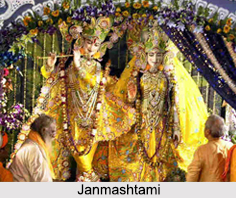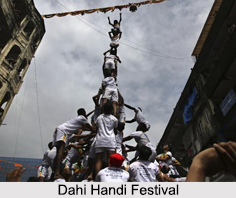 As per the Hindu calendar, the festival of Janmashtami is observed on the eighth day of the dark fortnight of the month of Shraavana which corresponds with the Gregorian calendar months of August and September. Also known as Krishna Janmashtami or Gokulashtami, the festival of Janmashtami is particular to the Vaishnavism tradition in Hinduism, which celebrates the birth of Lord Krishna.
As per the Hindu calendar, the festival of Janmashtami is observed on the eighth day of the dark fortnight of the month of Shraavana which corresponds with the Gregorian calendar months of August and September. Also known as Krishna Janmashtami or Gokulashtami, the festival of Janmashtami is particular to the Vaishnavism tradition in Hinduism, which celebrates the birth of Lord Krishna.
Overview of Janmashtami
Known to be one of the most popular Hindu festivals, Janmashtami is celebrated in a huge manner in the historical twin cities of Mathura and Brindavan in the state of Uttar Pradesh. It is here that Lord Krishna spent his childhood and thus the festive spirit of devotion runs high among the people. There are about 400 temples dedicated to Lord Krishna in these sacred cities and the major festivities are held at the Banke Bihari, Rangaji, Shri Krishna Balram and Gopinath temples. The `Raslila` of Braj is thematically the basis of many performing arts. Professional drama troupes or even young children perform Raslilas. Colourful costumes and equally colourful backgrounds are a special attraction of these shows. The play is enacted in the local language, Braj bhasha, but sometimes Hindi is also used.
Janmashtami is celebrated in a grand way in the Dwarkadhish temple in Mathura, in the form of Jhulanotsava and the Ghatas during the entire month. In Jhulanotsava, swings are placed in houses and temple courtyards, embellished with bells and flowers, for welcoming baby Krishna. The Ghatas are a unique feature of the month long celebrations where all the temples and the deities are decorated in the same colour in accordance to a particular theme. Jhanki is another prominent feature of Janmashtami where the scenes from the life of Krishna are depicted.
The festival of Janmashtami is followed by another festival called Nandotsav, which celebrates the occasion when Nanda Baba, the foster father of Lord Krishna distributed gifts to the community in honour of the birth.
 Legend behind Janmashtami
Legend behind Janmashtami
Lord Krishna was born in an era of chaos, when persecution was rampant and evil was everywhere. His biological parents were Vasudeva and Devaki, who was the sister of the tyrant ruler Kansa, who wanted to kill Krishna because a prophecy said that his sister"s eighth child will bring his doom. Lord Krishna is the eighth avatar of Lord Vishnu and thus the 8th child of Devaki, who was prophesised to kill his uncle Kansa.
Immediately following his birth at Nathdwara, Vasudeva took Krishna across the Yamuna River to foster parents in Gokul, named Nanda and Yashoda. This legend is celebrated on Janmashtami by people keeping fast, singing devotional songs of love for Krishna, and keeping a vigil into the night. Then the statues of baby Krishna are washed and clothed, then placed in a cradle. The devotees then break their fast, by sharing food and sweets. Women draw tiny foot prints outside their home doors and kitchen, walking towards their house, a symbolism for Krishna`s journey into their homes.
Rituals of Janmashtami
On Janmashtami, devotees keep a strict fast. This is broken only at midnight, the time of Krishna`s birth. At midnight, the idol of baby Krishna is placed in a small, decorated cradle, which is rocked while singing hymns. Then, `Panch aarti` is performed and the image is bathed with Gangajal in a mixture of curd, milk, honey, dry fruits and tulsi leaves. This mixture is then distributed as `Prasad` and partaking of it breaks the fast. Passages from holy books like Bhagavad Gita and Bhagavata Purana are recited.
Celebrating Janmashtami in Different States
In cities like Mumbai and Pune, the ritual of Dahi Handi is celebrated a day after the festival of Janmashtami. Dahi Handi means an earthen pot of yogurt and the festival gets this popular regional name from legend of baby Krishna, who would seek and steal milk products such as yoghurt and butter and people would hide their supplies high up out of the baby`s reach. Krishna would try all sorts of creative ideas in his pursuit, such as making human pyramids with his friends to break these high hanging pots.
In the state of Maharashtra, the legend of Krishna is played out as a community tradition on Janmashtami, where earthen pots filled with yogurt is hung up and teams of youth gather around in a pyramid and try to break the pot.
In the eastern and north eastern states of India, the festival of Janmashtami dates back to the efforts and teachings of 15th and 16th century Sankardev and Chaitanya Mahaprabhu. The festival is widely celebrated by the Hindu Vaishnava communities. In the eastern state of Odisha, specifically the region around Puri and in Nabadwip, in the state of West Bengal, the festival is also referred to as Sri Krishna Jayanti or simply Sri Jayanti.





